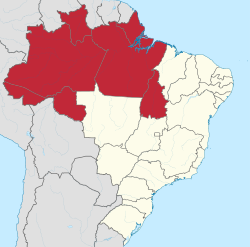Northern Region, Brazil
|
North Region Região Norte |
|
|---|---|
| Region | |
 Location of North Region in Brazil |
|
| Coordinates: 3°7′45″S 60°1′17″W / 3.12917°S 60.02139°WCoordinates: 3°7′45″S 60°1′17″W / 3.12917°S 60.02139°W | |
| Country |
|
| States | AC, AP, AM, PA, RO, RR and |
| Area | |
| • Region | 3,853,676.9 km2 (1,487,913.0 sq mi) |
| Area rank | 1st |
| Population (2016 census) | |
| • Region | 17,707,783 |
| • Rank | 4th |
| • Density | 4.6/km2 (12/sq mi) |
| • Density rank | 5th |
| • Urban | 75.6% |
| GDP | |
| • Year | 2014 |
| • Total | R$308 billion (5th) |
| • Per capita | R$17,879 (4th) |
| HDI | |
| • Year | 2010 |
| • Category | 0.683 – medium (4th) |
| • Life expectancy | 71 years (4th) |
| • Infant mortality | 25.8 per 1,000 (2nd) |
| • Literacy | 88.7% (4th) |
| Time zone | BRT (UTC-04) |
| • Summer (DST) | BRST (UTC-03) |
The North Region of Brazil (Portuguese: Região Norte do Brasil) is the largest Region of Brazil, corresponding to 45.27% of the national territory. It is the least inhabited of the country, and contributes with a minor percentage in the national GDP and population. It comprises the states of Acre, Amapá, Amazonas, Pará, Rondônia, Roraima and .
Its demographic density is the lowest in Brazil considering all the regions of the country, with only 3.8 inhabitants per km2. Most of the population is centered in urban areas.
Belém International Airport and Manaus International Airport connect the North Region with many Brazilian cities and also operate some international flights.
The North is home to the Federal University of Amazonas and Federal University of Pará.
The Amazon represents over half of the planet's remaining rainforests and comprises the largest and most species-rich tract of tropical rainforest in the world. Wet tropical forests are the most species-rich biome, and tropical forests in the Americas are consistently more species rich than the wet forests in Africa and Asia. As the largest tract of tropical rainforest in the Americas, the Amazonian rainforests have unparalleled biodiversity. More than 1/3 of all species in the world live in the Amazon Rainforest.
...
Wikipedia
